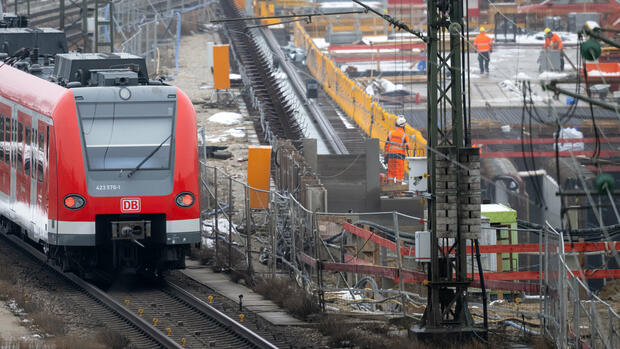The federal government and the railways had agreed to fundamentally rehabilitate heavily used rail routes.
(Photo: dpa)
Berlin In the future, the federal government wants to contribute far more to the costs of the rail network than has been the case up to now. This emerges from a draft for the reform of the railway expansion law, which is available to the Handelsblatt. The “additional financing options” are intended to fundamentally overhaul the so-called “high-performance corridors” on the rail network.
This involves 4,300 kilometers of rail routes that are particularly busy. All measures are to be “contractually agreed between the federal government and the federal railways,” the draft says.
According to the draft law, the federal government will provide the infrastructure company of Deutsche Bahn AG with 7.5 billion euros by 2027, for example to maintain and digitize the existing rail network or to convert and expand train stations to be barrier-free. They should flow from the 45 billion euros for the railways, on which the SPD, Greens and FDP had agreed in the coalition committee.
The sum, which corresponds to almost a doubling of the funds for rail in the transport budget, had been requested by Deutsche Bahn for additional investments from 2024 to 2027. Part of the money is to flow from the truck toll, which Wissing wants to double from the end of the year.
In view of the dilapidated rail network, Minister Wissing and rail boss Richard Lutz agreed a good year ago to start from 2024 with the fundamental renovation of particularly heavily used rail routes. Of the 43 identified route sections, the route between Mannheim and Frankfurt, the so-called Riedbahn, is to be completely closed for five months and renovated and modernized.
2.2 billion extra for the rails in the coming year
The goal: In the future, there should only be one construction site with a full closure for about five months on the important routes and then no more disruptions for many years. According to the draft law, 2.2 billion euros are already planned for 2024. By 2030, at least half of the 4,300 kilometers will be renovated and modernized.
“The concept of ‘renovation under the rolling wheel’ failed,” says Minister Wissing. With the new strategy, the railway will resolve the “permanent congestion” in the network. To do this, however, they first have to lay “bypasses”, i.e. strengthen bypasses of the planned closed sections beforehand, so that freight trains can continue to run. Experts anticipate massive problems, as many branch lines are in poor condition. The passenger replacement service is to be handled by local transport, which, in the case of the Riedbahn, should consist of 200 buses.
The Federal Minister of Transport hopes that the railway network will be renovated quickly.
(Photo: IMAGO/image enclosure)
With the renovation, the federal government hopes that significantly more trains will be able to run on the existing network. According to the draft law, the rail network is to “take an increasing share of traffic growth as a driver for energy-efficient and climate-friendly transport”.
The network is currently “too small” to enable more transport and thus make a contribution to climate protection. The construction of new routes is necessary, says Wissing. “But it doesn’t solve our problems.”
New company to make the railway network fit
The Federal Ministry also justified the swing in funding with the United Nations’ sustainability goal of building a resilient infrastructure. The plan helps to achieve the goal “by enabling the federal government to provide financial support for scheduled and preventive maintenance measures on the rail network of the federal railways”. Bahn AG currently has to bear the costs of maintaining the network, for example. To this end, the infrastructure company DB Netz charges track access charges and receives funds from the Group.
The legislative plan is part of the planned reform of the railway system. The traffic light coalition has set itself the goal of converting DB Netz AG and DB Station and Service, as infrastructure divisions of the federally owned Bahn AG, into a society geared towards the common good. However, they should remain part of the Bahn Group.
At the same time, the federal government wants to be able to exert more influence on the way in which the infrastructure company maintains and expands the rail network. The train is currently less punctual than it has been for a long time, which is also due to the poor condition of the network and the large number of construction sites required to maintain the system at all.
More: Wissing wants to build motorways faster – also for military emergencies
